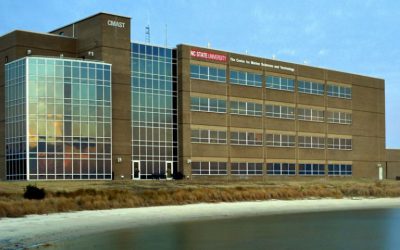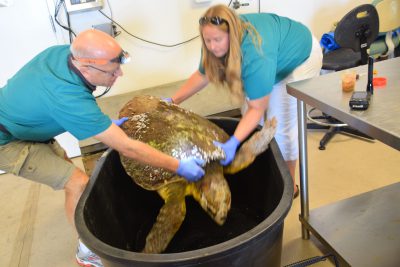MOREHEAD CITY — Dr. Craig Harms had planned on spending the day writing parts of a book he was co-authoring. The subject he was focused on was sea turtle rescue and rehabilitation, so it was no surprise when a sea turtle emergency put an end to his quiet plans for the day on Sept. 27, 2016.

That morning, a weak loggerhead sea turtle had been found washed up at Cape Lookout. Within a few hours, it would arrive at North Carolina State University’s Center for Marine Sciences and Technology in Morehead City where Harms, the resident veterinarian, would take a look at the ill turtle.
Supporter Spotlight
CMAST is the university’s 52,000-square-foot marine sciences lab. The center serves as home base for university researchers, resident veterinarians and graduate students. Educators also hold classes for both NCSU and Carteret County Community College students in the upper floors of the building, which is located on the community college campus.
The center is one of three university labs along the Crystal Coast. The other two labs are the University of North Carolina Institute of Marine Science in Morehead City and the Duke University Marine Lab on Pivers Island near Beaufort. Each lab serves as offices for graduate students, researchers and staff that work to understand the coastal areas and oceans.
CMAST has programs allow participants to interact with and better understand animals directly. This role has given the lab a unique place in the community. Since its establishment in 1997, CMAST has become partners with the Karen Beasley Sea Turtle Rescue and Rehabilitation Center in Surf City and North Carolina Aquariums in efforts to care for sick or injured marine life.

As for his position as a veterinarian and director of the Marine Health Program at CMAST, Harms calls it a “sweet” deal.
“I get to work with the vet school, but I get to be based down here,” Harms said. A large window in his office provides a sweeping view of the waters of Bogue Sound behind him. At the lab, Harms has the resources to provide treatment to animals, including sea turtles and marine mammals, and conduct necropsies if needed.
Supporter Spotlight
Other programs at CMAST include marine environmental toxicology, which studies the effects of toxins in the marine environment; fisheries ecology, which studies fish population sizes; and a seafood science lab, which assesses the product safety and processing of seafood.
Through his work at CMAST, Harms conducts research on best ways to treat aquatic animals. For example, if a researcher needs to perform surgery on a fish to implant a tracking device, Harms finds surgery methods that reduce inflammation and reduce the likelihood of losing the device.
He has also pioneered humane methods to euthanize large whales that are beyond saving.
“It’s absolutely not the thing I thought I was going to be doing in vet school,” he said, “coming up with really complicated, large-scale techniques to euthanize a really big animal humanely and safely for the environment and for the scavengers.”
When sea turtle emergencies spring up, however, Harms takes off his researcher hat and puts on his veterinarian one.

When the nearly three-foot-long sea turtle from Cape Lookout arrived at the facility later that day, it was covered in gooseneck barnacles, a bad sign. The excessive barnacles create drag, making it difficult for the turtle to swim quickly. Harms said the turtle was also missing a hind flipper and may have had cataracts.
As Harms and Heather Broadhurst, a research technician, handled the turtle, it tried feebly to fight back. At this point, the reason for the turtle’s weakness was unknown, but Harms and Broadhurst described the turtle as “depressed.”
Harms said a turtle that size shouldn’t be so easy to handle.
Further assessment of the turtle revealed it to be about 20 years old, still a juvenile, and at more than 100 pounds, the turtle was too skinny. Harms said that there was about 10 pounds of sediment alone on the turtle that needed to be cleaned off.
The turtle was moved to a black tub, where it wheezed heavily under its own weight. Later in the day, a weeks-old gash was discovered in the turtle’s carapace, or shell, that exposed its lung. Despite the turtle’s various ailments, Harms said the wound should eventually heal well at the Karen Beasley sea turtle rehabilitation center in Surf City.
There are two primary sea turtle rehabilitation facilities in the state. Harms is the primary veterinarian for the sea turtle hospital in Surf City while a former resident works with an North Carolina Aquariums facility in Manteo.
Harms said that working with sea turtles is rewarding because many of them are able to recover and be released. He estimated that 80 percent of the turtles that come in are rehabilitated. He recalled an experience where a turtle with a skull fracture and exposed brain made a full recovery.
“When sick and injured animals come in, people expect something to be done and we are able to do that with the sea turtles,” he said.

While sea turtles may be able to get back to the water, many other aquatic creatures aren’t so lucky. One of Harms’ colleagues at CMAST, Victoria Thayer, the coordinator of the North Carolina Central Coast Marine Mammal Stranding Network, rescues marine mammals when she can, but collects as much data about them when she can’t.
The network is a collaboration with the state Division of Marine Fisheries and CMAST. Thayer and her team respond to calls about beached and stranded marine animals, including dolphins, whales and ice seals. More often than not, the animals have already died by the time help arrives.
When Thayer’s team finds a dead animal, it conducts a necropsy, documents measurements and takes photographs. She said they’re meticulous because of the insight the strandings can provide.
“A lot of what we know about some of these species only comes from stranded animals,” Thayer said.
Harms said the information that comes to CMAST and its staff this way is unique and valuable.
“In all cases we learn as much as we can about them and about the environment that they came from and what stressors and impacts that they might be dealing with,” he said, “which is important to the health of our environment.”








